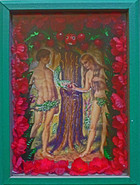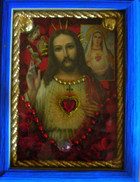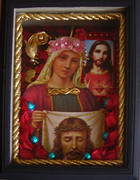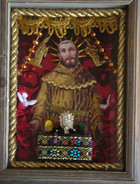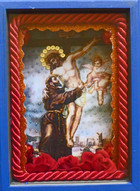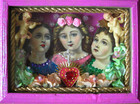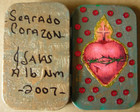Johnny Salas
The dividing lines between fine art, pop art, consumer art, and kitsch have all but disappeared in the post-modernist scene. Such distinctions have never been important in sacred art. No one venerates an icon for its color or composition. Critics may dismiss Warner Sallman’s Head of Christ as a second-rate painting, but there is no denying its emotive power as a mass-produced image for millions of American Protestants. The same holds true for affordable reproductions of Christ, the Blessed Virgin Mary and the Saints, which find favor with Roman Catholics.
New Mexican Saint-Maker Johnny Salas is an avid collector of such popular (populist) holy pictures, incorporating them into his own glittering variations of traditional Hispanic “shadow boxes, folk art pieces which display 3-D images under glass in box-line frames. Spanish Colonial Market organizers have snubbed Salas’ work as “folk kitsch.” But however you choose to describe Salas’ art, viewers certainly take a second look at these eye-catching pieces, when they recognize familiar sacred pictures they too often ignore in such theatrically-heightened settings!
The Albuquerque artist, himself, makes light of what he does, calling it “spiritual candy for the eye,” but his intentions are serious enough. When Johnny was a little boy, his Grandmother Teresita encouraged him to embellish paper reproductions of his favorite saints with trinkets he found around the house as a special act of devotion. Later in life, when Salas wanted to show his gratitude to God for an answered prayer at the healing shrine in Chimayo, New Mexico, this holy intention blossomed into the gold lame-decked, bauble-encrusted shadow boxes on display here.
